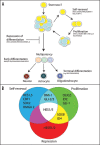Transcription factors and neural stem cell self-renewal, growth and differentiation
- PMID: 19535895
- PMCID: PMC2802757
- DOI: 10.4161/cam.3.4.8803
Transcription factors and neural stem cell self-renewal, growth and differentiation
Abstract
The central nervous system (CNS) is a large network of interconnecting and intercommunicating cells that form functional circuits. Disease and injury of the CNS are prominent features of the healthcare landscape. There is an urgent unmet need to generate therapeutic solutions for CNS disease/injury. To increase our understanding of the CNS we need to generate cellular models that are experimentally tractable. Neural stem cells (NSCs), cells that generate the CNS during embryonic development, have been identified and propagated in vitro. To develop NSCs as a cellular model for the CNS we need to understand more about their genetics and cell biology. In particular, we need to define the mechanisms of self-renewal, proliferation and differentiation--i.e. NSC behavior. The analysis of pluripotency of embryonic stem cells through mapping regulatory networks of transcription factors has proven to be a powerful approach to understanding embryonic development. Here, we discuss the role of transcription factors in NSC behavior.
Figures

References
-
- Choi CQ. A stroke for stem cells. Sci Am. 2007;296:8–9. - PubMed
-
- Reynolds BA, Weiss S. Generation of neurons and astrocytes from isolated cells of the adult mammalian central nervous system. Science. 1992;255:1707–1710. - PubMed
-
- Singh SK, Hawkins C, Clarke ID, Squire JA, Bayani J, Hide T, et al. Identification of human brain tumour initiating cells. Nature. 2004;432:396–401. - PubMed
-
- Ivanova NB, Dimos JT, Schaniel C, Hackney JA, Moore KA, Lemischka IR. A stem cell molecular signature. Science. 2002;298:601–604. - PubMed
Publication types
MeSH terms
Substances
LinkOut - more resources
Full Text Sources
Other Literature Sources
Medical
